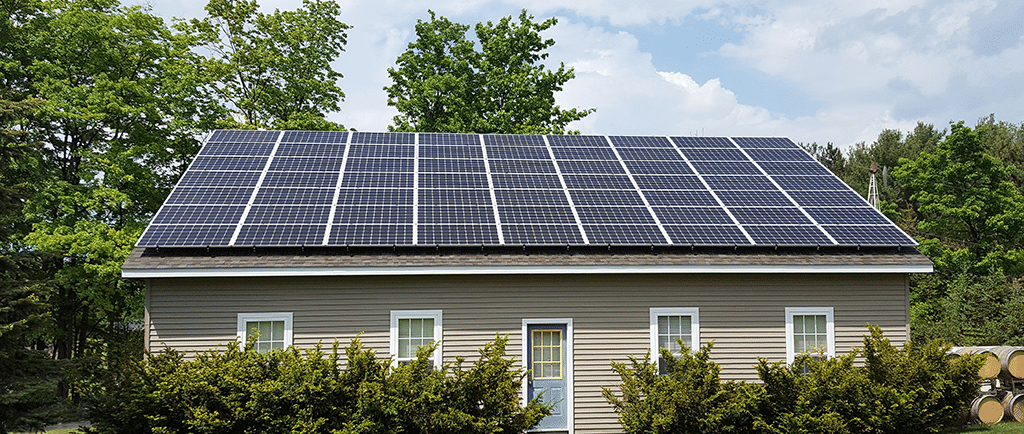The average Michigan customer could save $773 per year through 2050 compared to current utility plans, if the state electrified transportation and heating to meet Governor Gretchen Whitmer’s clean energy executive directive, and made optimal investments in renewables.
Those savings could be achieved through the lowest-cost of three scenarios modeled by Vibrant Clean Energy using its WIS:dom-P optimization model, in a study commissioned by Vote Solar.
Retail rates in Michigan would fall from 11.4 cents/kWh in 2018 to about 7 cents/kWh in 2030 in either of the two decarbonization scenarios. The savings would result from adoption of efficient electric vehicles and heat pumps, more rapid displacement of fossil generation with low-cost renewables balanced with storage, and the spreading of fixed utility costs over the larger demand created by EVs and heat pumps.
The decarbonization scenario with the lowest costs went a step further to co-optimize transmission and distribution investments, yielding modest additional rate savings through 2050 by deferring distribution system capital investment.
Distributed solar in Michigan would reach 3GW by 2035 in the lowest-cost scenario, while distributed storage would reach 2.1GW. Current utility plans call for no additional distributed solar or storage beyond minimal existing levels.
While distributed solar and storage would be higher under the lowest-cost scenario, utility-scale solar would be lower, at 3.6GW in 2035, versus 7.8GW under current utility plans.
The study found tremendous untapped land-based wind capacity in Michigan, with the lowest-cost scenario adding 21GW of wind power by 2035, compared to 4.4GW under current utility plans.
The modeling “supports increasing and incenting local solar-plus-storage,” said Will Kenworthy with Vote Solar, in a webinar presenting the study.
The study, which Vote solar submitted in its comments on the draft Michigan Healthy Climate Plan prepared by Governor Whitmer, showed that the governor’s goals are achievable, said Kenworthy. Michigan should “start now” to get to 50% clean energy by 2030, as “getting the first 50% is a no regrets policy” he said. Vote Solar supports a Michigan renewable energy standard of 50% by 2030, a goal stated in Michigan’s draft plan, he said.
In a key adjustment, the model counted the goal of the utility Consumers Energy to reach 90% decarbonization by 2040 as part of the utility’s current plans, and so added in the “current plans” scenario 1.8GW of utility-scale solar to the amounts shown in the utility’s resource plan and that of utility DTE, from which Consumers imports power. The resource plan proposed by Consumers through 2034 “falls well short of reaching its own decarbonization goal by 2040,” the study says.
The planning models used by Michigan utilities are “insufficient,” said John Delurey with Vote Solar, on a webinar presenting the study, and the utilities should use a model more like Vibrant Clean Energy’s model, with its ability to identify the savings potential from distributed solar and storage.
VCE’s model combines capacity expansion modeling and production cost modeling, Kenworthy said. The two types of modeling are sometimes conducted using separate models.
The VCE study used costs for generation capital and O&M from the NREL ATB 2020 “advanced” cost projections, and used fuel costs from EIA’s Annual Energy Outlook High Oil and Gas supply scenario.
Vibrant Clean Energy has previously conducted optimization models for the entire US and for “a couple of other states,” Kenworthy said.
This content is protected by copyright and may not be reused. If you want to cooperate with us and would like to reuse some of our content, please contact: editors@pv-magazine.com.








By submitting this form you agree to pv magazine using your data for the purposes of publishing your comment.
Your personal data will only be disclosed or otherwise transmitted to third parties for the purposes of spam filtering or if this is necessary for technical maintenance of the website. Any other transfer to third parties will not take place unless this is justified on the basis of applicable data protection regulations or if pv magazine is legally obliged to do so.
You may revoke this consent at any time with effect for the future, in which case your personal data will be deleted immediately. Otherwise, your data will be deleted if pv magazine has processed your request or the purpose of data storage is fulfilled.
Further information on data privacy can be found in our Data Protection Policy.